

Unlock the Key Differences Between DevOps and SRE






Supervising large and critical systems that function relentlessly and promptly respond to new requirements is challenging. This makes SRE and DevOps essential.
A primary characteristic of SRE is closing the gap between development and operations by maintaining system reliability and stability through engineering practices. SRE (Site Reliability Engineering) is a software-oriented approach specifying the need to build and sustain coherent systems.
On the other hand, DevOps focuses on accelerating delivery by improving the working relationship between development and operation teams. Both are crucial to implementing the right strategy, especially when you need a reliable and adaptable system to meet changing business needs.
In this blog, we examine the different characteristics of SRE and DevOps, how they align with your organization's infrastructure goals, and optimize operations for reliability and speed.
SRE is a specialized approach that combines software engineering principles with IT operations to maintain reliable and scalable systems. They self-schedule tasks like software deployment, system scaling, and monitoring, which do not require human intervention and are prone to errors in some circumstances.
Regarding issue management, SREs focus on preventing downtime by addressing problems like high latency, resource bottlenecks, and security vulnerabilities before they escalate. To ensure reliability and performance, they do this through real-time monitoring and alerting systems, incident management frameworks, and root cause analysis.
The concept of SRE started at Google in 2003 as a systematic method to maintain the stability of their services. Service Level Indicators (SLIs) are central to this approach, which measures a service's performance from a user’s perspective.
For example, if a web application frequently fails to respond, an SLI would track the frequency of these issues, allowing the SRE team to take appropriate action and improve the user experience. This systematic and data-driven approach makes SRE a crucial component of current IT processes, reducing disruptions and improving system performance.
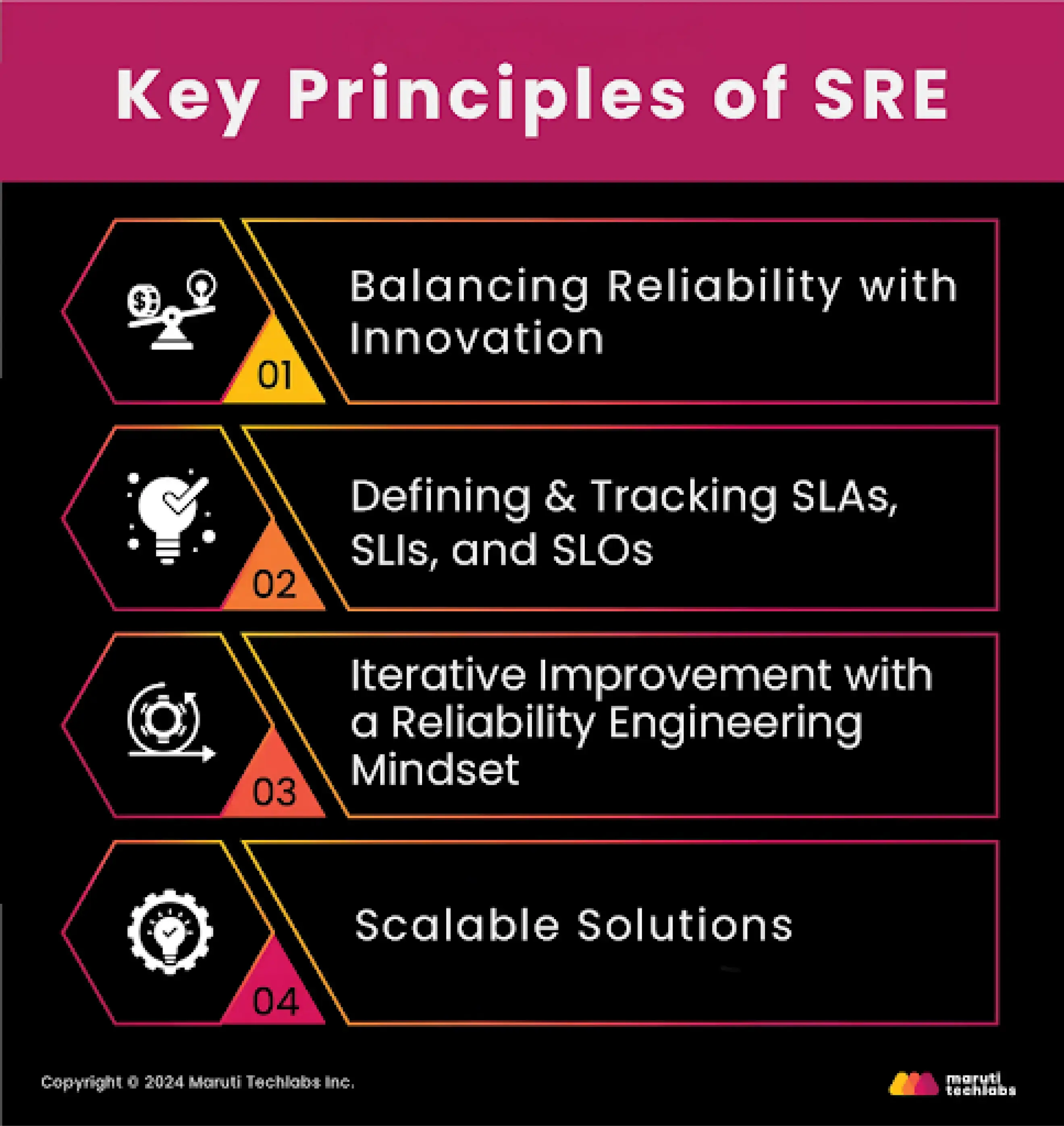
Here are the fundamental principles that guide Site Reliability Engineering (SRE) practices:
SRE teams don’t aim for perfection but balance innovation and stability. They understand that striving for 100% uptime might frequently be impossible and that some failure is acceptable to promote faster advancement.
These metrics establish clear system performance expectations. Service Level Agreements (SLAs) represent the promises made to customers. In contrast, Service Level Indicators (SLIs) and Service Level Objectives (SLOs) are internal measures that help ensure the system fulfills those promises.
SREs focus on making small, consistent changes to enhance system reliability and efficiency. They apply software engineering principles to prevent failures rather than merely reacting to issues. This approach minimizes disruptions and improves continuous learning and optimization.
Additionally, Automation plays a crucial role in SRE by automating repetitive tasks to reduce human error and improve system performance. Blameless Postmortems further strengthen the process by encouraging teams to learn from incidents without attributing fault, ensuring continuous improvement without fear of blame.
Every action SRE takes is creating solutions that work at scale, from handling increased traffic to managing complex infrastructure. The goal is always to build systems that can grow without compromising efficiency.
With a clear understanding of SREs and principles, let’s explore the DevOps approach and see how it compares to principles and practices.
DevOps is a cultural shift that unites development and operations into one cohesive unit. Traditionally, development and operations functioned separately—developers wrote code while operations teams handled testing and deployment. This divide often led to inefficiencies, delays, and miscommunication.
DevOps facilitates collaboration throughout the entire software lifecycle. This integrated approach ensures that code is developed, tested, and deployed continuously, creating a smoother workflow. It’s about breaking down silos and fostering a culture where everyone is responsible for both the quality and dependability of the software.
Today, DevOps teams consist of professionals with diverse skills who collaborate from planning to deployment. This teamwork leads to faster product launches, issue fixes, and more flexible software development. DevOps combines development and operations to address the demands of a constantly changing digital environment, enabling businesses to produce products more quickly and effectively.
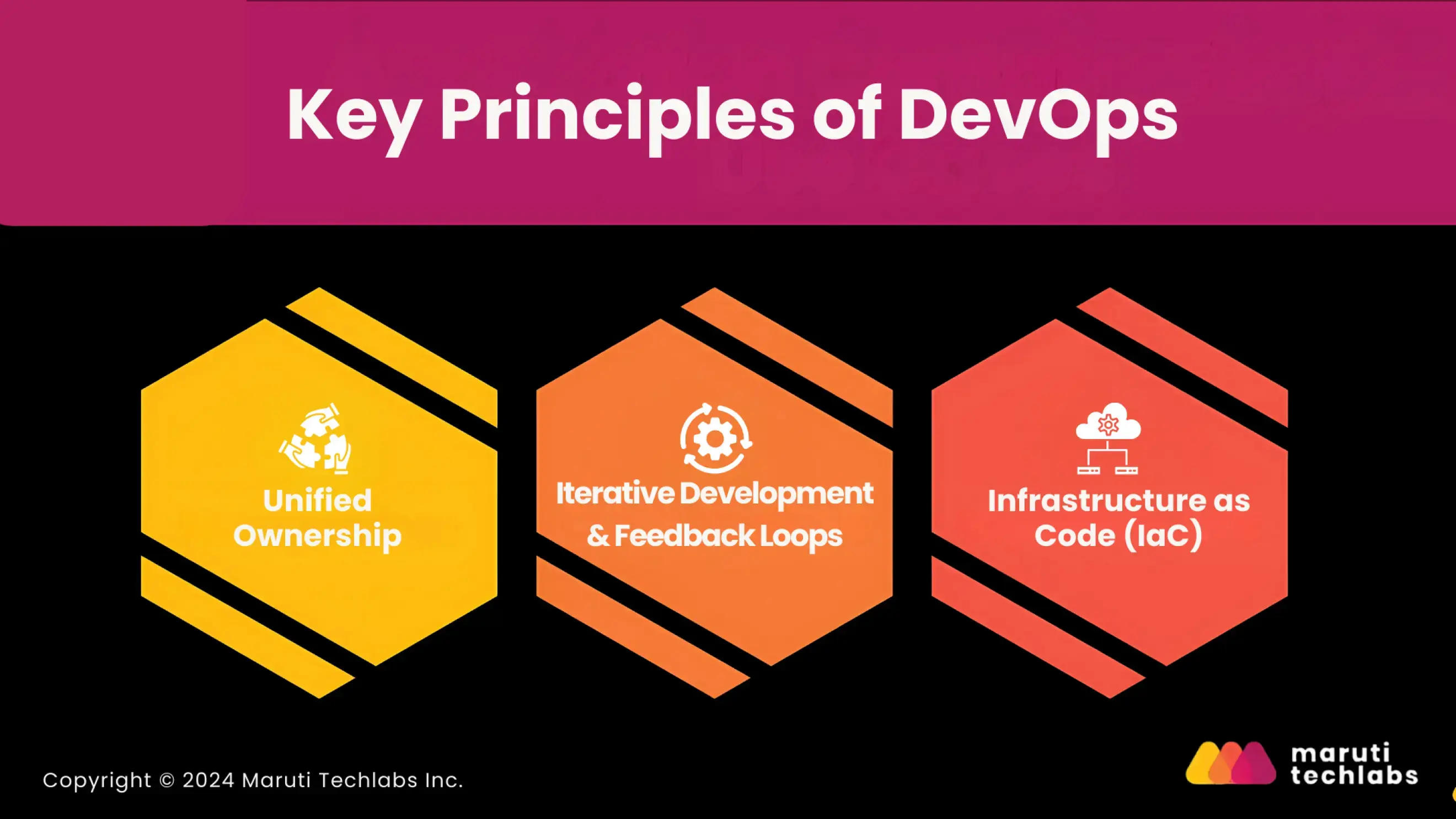
Let’s observe the fundamental principles that guide DevOps practices:
DevOps promotes the idea that the entire team owns the product from development through release, improving accountability and encouraging a culture of shared responsibility. This cultural shift goes beyond tools and processes—DevOps is about creating an environment where collaboration, transparency, and continuous learning from successes and mistakes are ingrained in everyday practices.
While development teams focus on building the product, SRE teams often manage deployment and ensure reliability.
DevOps teams leverage automation tools like Continuous Integration and Continuous Deployment (CI/CD) to streamline the entire lifecycle—from code integration to deployment. By automating these processes, teams can gather continuous feedback at each stage, allowing quicker responses to changes and aligning products with customer needs. This results in faster releases, reduced manual errors, and optimized workflows.
With Infrastructure as Code (IaC), DevOps enables teams to manage and provision infrastructure through code, ensuring consistency and reducing the risk of configuration drift. This approach allows teams to automate infrastructure management, making scaling and replicating environments easier while maintaining reliability and compliance.
Having explored DevOps and its essential principle, let’s examine how DevOps and Site Reliability Engineering (SRE) differ.
Here's how various aspects, from their core focus to their team structures and responsibilities differ between SRE vs DevOps.
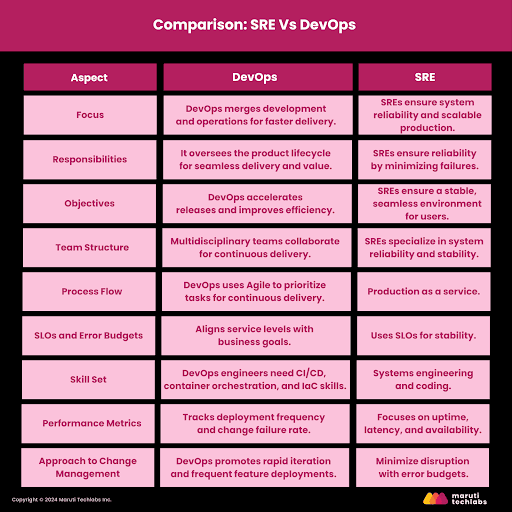
Having outlined the differences between DevOps and SRE, it's time to delve into what truly sets SRE apart in practice.
Let's examine the key responsibilities that make SREs crucial in building reliable, scalable, and efficient systems.
Here are the core responsibilities of SREs, the essential tools they rely on, and the key metrics used to measure their success.
SRE is critical in maintaining system accuracy and effectiveness. Here is a list of their prominent roles:
SRE teams are always looking for system issues, aiming to catch them before they become serious problems. They rely on metrics and real-time data to keep applications operating efficiently.
By examining system performance, they take proactive steps to optimize resource usage, which helps to minimize downtime and ensures a smooth user experience. This approach reduces disruptions and keeps the system running efficiently over time.
One of the critical duties of SREs is ensuring that services are available whenever requested and maintaining system availability. SREs monitor latency frequently to respond quickly without compromising user experience. They also create systems that scale efficiently, meeting rising demand or traffic levels without sacrificing functionality.
SREs respond quickly to occurrences to minimize interruptions and address problems. They don’t just fix problems; they dive deep to identify the root cause, ensuring the same issue doesn’t happen again. This proactive approach helps maintain high reliability and user trust in the system.

SREs constantly look for opportunities to automate repetitive tasks. Automating manual processes like deployments, testing, and monitoring gives time to focus on more complex challenges. This approach reduces human error and enhances overall efficiency, ensuring systems remain reliable and up-to-date.
SREs work closely with development teams, sharing insights and feedback to improve system reliability from the ground up. This collaboration ensures that reliability is considered during the software development, resulting in more robust and stable applications. The combined effort leads to faster deployments and fewer issues down the line.
To effectively manage reliability and performance, SREs rely on a variety of specialized tools. Let’s observe them briefly.
SREs track specific metrics to measure system reliability and optimize performance:
With a clear understanding of SRE’s responsibilities, let’s explore how DevOps compares in terms of responsibilities.
Here are the key responsibilities of DevOps teams, the essential tools they utilize, and the key metrics used to track their performance.
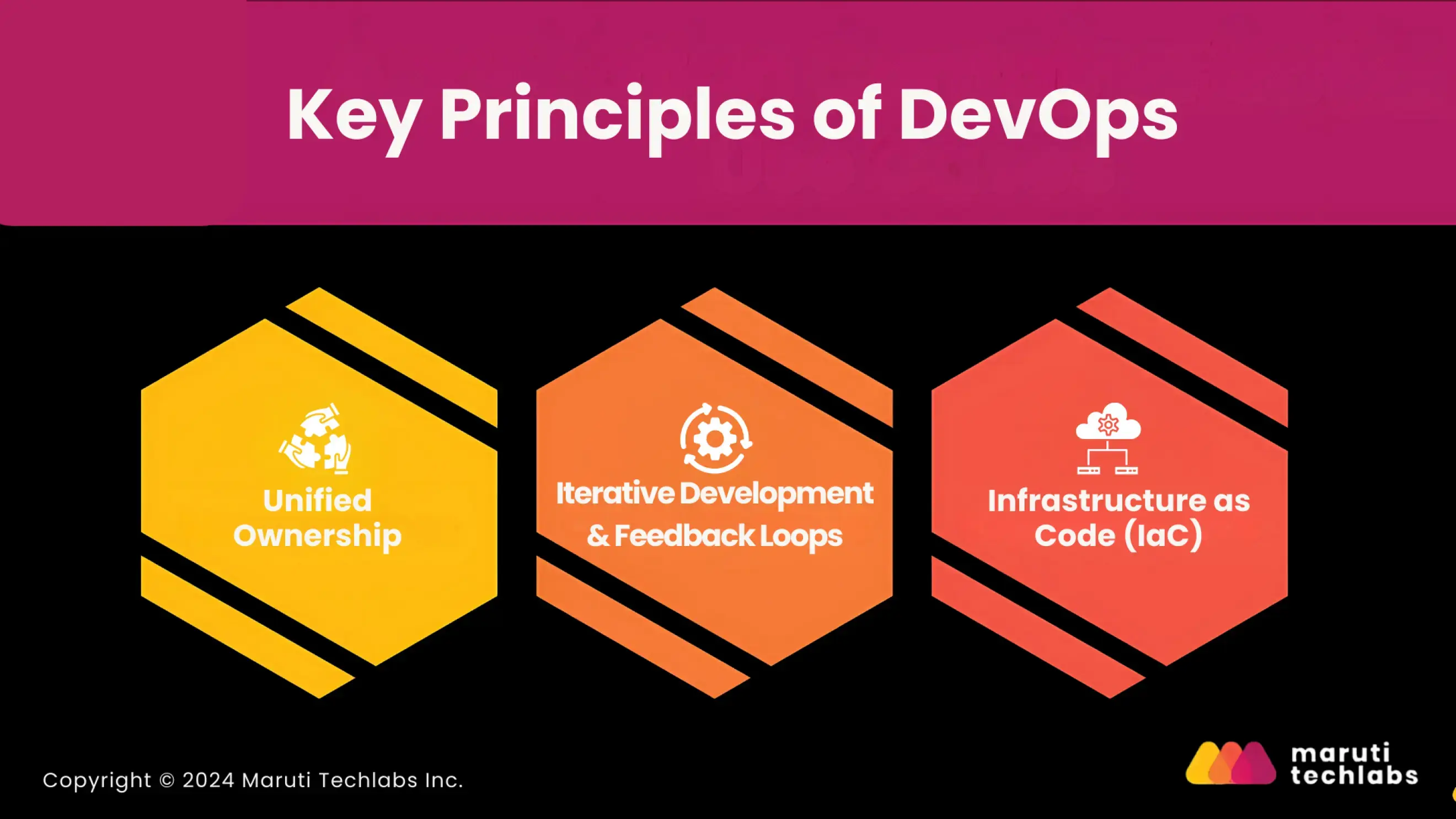
DevOps ensures software flows seamlessly from planning to production by bridging the gap between development and operations. Here’s a closer look at the core responsibilities:
DevOps encourages teamwork across development, operations, and other stakeholders. Instead of working in isolation, teams collaborate to identify issues early, streamline workflows, and align projects. This collaboration helps avoid bottlenecks, enabling quicker decision-making and reducing the back-and-forth that slows down processes.
DevOps doesn’t just stop at building software; it actively focuses on refining it throughout its lifecycle. By working closely with developers, DevOps teams integrate code changes continuously, ensuring software evolves in line with project goals and user needs. This hands-on involvement helps maintain quality and adaptability.
CI/CD is fundamental to DevOps. Continuous Integration involves frequently merging code changes, ensuring issues are detected early. Continuous Delivery means preparing these changes for release as soon as they’re ready. This approach minimizes downtime, allowing faster and more reliable software deployment.
Automation is critical in DevOps, eliminating repetitive tasks and reducing the chance of errors. By automating testing, potential bugs are caught early, and automated deployment ensures consistent, smooth rollouts. Because of this efficiency, teams can concentrate more on invention and less on manual checks.
DevOps manages infrastructure using a code-driven approach called Infrastructure as Code (IaC). This approach makes configuring, managing, and scaling resources easier and ensures systems remain responsive to changing demands. It’s about creating an environment where the infrastructure is as adaptable as the software.
Successful DevOps adoption requires using several tools to ensure smooth collaboration, automation, and integration. Here is a list of the most essential tools needed by DevOps teams.
To evaluate the success of DevOps practices, teams track key metrics:
With a clear understanding of DevOps responsibilities, let's shift our focus to the real-world problems SRE teams are adept at solving and how they add value to the development process.
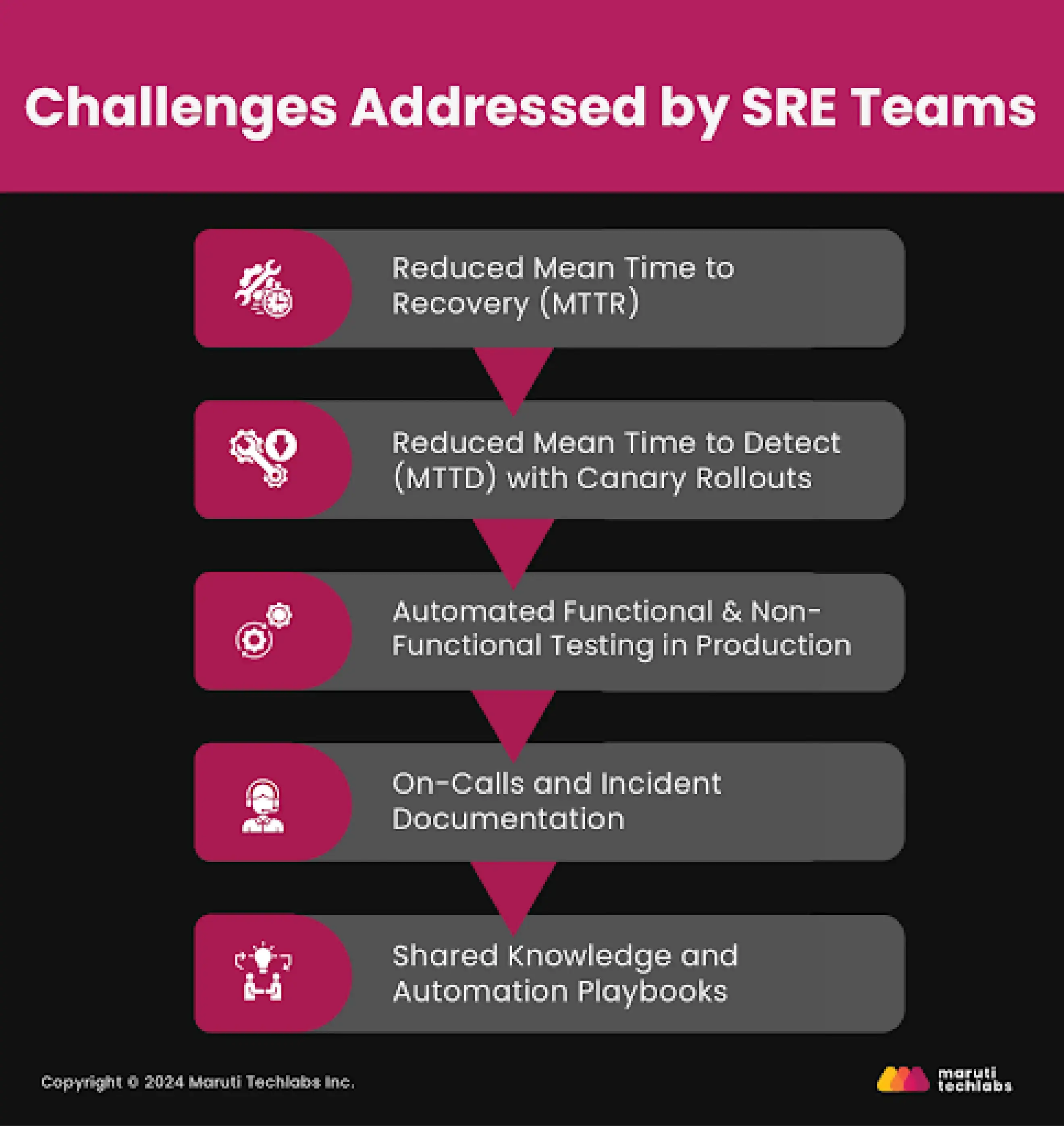
SRE teams bring a unique blend of engineering skills and operational discipline to keep systems running smoothly.
Here’s how they tackle some of the most critical challenges.
When anything goes wrong, time runs out—every second matters. SRE teams concentrate on rapidly identifying the problem and implementing a solution to minimize downtime significantly.
With playbooks and automated recovery processes, they can quickly address events and get things back on track without the typical hiccups or delays. With this strategy, your services will have higher uptime, ensuring a better user experience.
Preventive measures are far better than curative measures in a crisis. A key component of these SREs is the utilization of monitoring services, which check the behavior and performance of the system in real-time, often to find problems that have surfaced.
In the same context, SRE teams use canary rollouts, a strategy that deploys individual pieces of updates to a minority of individuals before an entire launch. This helps them arrest and fix any emerging drawbacks within a safe environment before they go viral.
Through monitoring and canary rollouts, any slight issue can easily be detected and solved before it grows complex and causes system unavailability, thus preserving consumer confidence.
SREs don’t wait for issues to arise—they actively test and validate systems in real-world conditions. By automating tests for how a system functions (e.g., does it respond correctly?) and non-functional aspects (e.g., performance under load), they catch potential problems that might not surface in a controlled testing environment.
This proactive testing ensures the software remains reliable, even when faced with unexpected challenges.
Here’s how these tests are implemented:
Automated scripts simulate real user interactions to verify if the software behaves as expected. For example, they ensure that APIs return correct data or that user workflows operate smoothly. These tests, often run during deployments with tools like Selenium or Postman, help maintain critical user functions even after updates.
These tests focus on performance, scalability, and security. SREs use tools such as Apache JMeter or Gatling to simulate heavy user loads or network traffic, assessing the system's stability under stress. Monitoring solutions like Prometheus and Grafana track important metrics, enabling early detection of potential bottlenecks.
SREs may use canary releases to minimize risks during updates, first deploying changes to a small subset of users. This allows functional and non-functional tests to run in a controlled segment of the production environment. The update is gradually rolled out to a broader audience if no issues are found.
Meanwhile, A/B testing helps compare configurations or code paths, ensuring optimal performance.
Chaos engineering allows SREs to test how systems react to unexpected failures by introducing deliberate disruptions, server outages, or network delays. Using tools like Chaos Monkey, they can evaluate the system's resilience and ability to recover from these disruptions, helping uncover potential fault tolerance weaknesses.
SRE teams are always prepared to respond when issues occur, often taking turns being “on-call” to handle emergencies. However, they do not just solve issues and cover them up—they document each event, who corrected it, what was done, why, and what was learned. This prevents repeating the same mistakes and defines the processes that constantly enhance the group or team.
SREs are against creating new things from scratch. When they discover workable answers, they write playbooks, which are comprehensive manuals that explain how to deal with typical problems. The team uses these playbooks to handle future issues quickly and retain valuable information, even when members leave or take on new responsibilities.
While SRE focuses on durability and security, DevOps teams address the hurdles of improving deployment pipelines, clearing bottlenecks, and enhancing teamwork between development and operations.
DevOps teams address various issues faced by businesses when developing software. Here’s how they make a difference.
DevOps teams significantly reduce the time and resources needed to develop, test, and deploy software by promoting automation and streamlined processes. This efficient method helps to minimize costly mistakes and reduces the reliance on manual processes.
Consequently, companies save money not just during development but also in ongoing maintenance. For example, by catching problems early through continuous testing and integration, DevOps helps avoid costly fixes later.
DevOps makes it easier to deliver new updates, patches, features, and improvements more often because it reintroduces automation and integrated collaboration among teams into the development process. This helps companies update their operations quickly, follow market trends, incorporate user feedback, and advance on market competitors.
The above release cycle is beneficial, especially for startup and established firms when looking for opportunities.
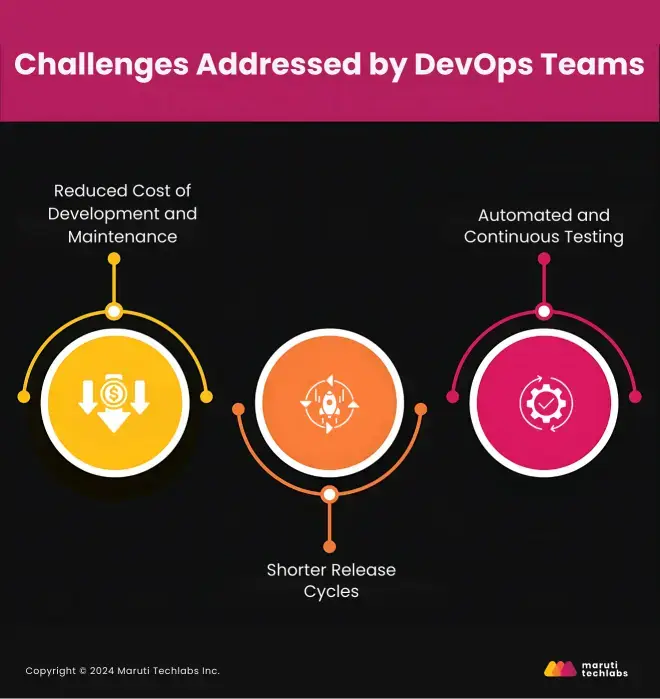
Conventionally, software testing was a manual activity, though it was performed at the final stage of the software development process. This approach was slow and inaccurate because it relied heavily on manual input and intake, holding back new feature releases.
In the past, DevOps teams used only the testing done on the manual processes, while today, there are testing features in the automated processes for the code quality and functionality. New automated tests are constantly incorporated into one’s development constellation to minimize when and if these incidents are produced to outcome. It results in a more dependable product, a uniform client experience, and a shorter completion time.
The collaborative relationship between DevOps and SRE facilitates faster software delivery and more reliable systems. Combined, we can offer on-time delivery and quality results that are flexible and adaptable to change.
DevOps seeks to optimize operations and development processes through automation, continuous integration, and continuous delivery (CI/CD). It places a strong emphasis on accelerating the development cycle by enhancing effective workflows and dismantling team silos.
SRE, on the other hand, strongly emphasizes preserving system stability and dependability. It assures systems are resilient even when new features are added quickly by implementing strict monitoring, incident response plans, and performance optimization tactics. DevOps and SRE work together to reconcile operational stability with fast innovation.
To preserve system efficiency, we should anticipate even more automation, improved monitoring, and closer integration of AI tools in the future. As these approaches advance, the partnership between DevOps and SRE will become more crucial for companies looking to stay competitive.
Maruti Techlabs can support your digital transformation journey. Leveraging our DevOps and Site Reliability Engineering (SRE) expertise, we deliver tangible results, simplifying software deployment for startups and enabling rapid product iterations that keep you competitive in a fast-paced market.
We focus on strategies for larger enterprises that boost scalability, reliability, and cost-effectiveness.
Contact us today if you’re ready to elevate your operations and drive growth. Let’s explore how Maruti Techlabs can help you stay ahead in your industry.
Yes, it’s possible to implement one without the other, but they work best together. DevOps helps streamline development and deployment, while SRE uses reliability practices that prevent downtime. For optimal results, especially in larger organizations or rapidly growing startups, integrating both practices ensures a balanced approach to speed and stability.
Integrating DevOps and SRE concepts into custom digital transformation solutions can improve your software delivery process. Our team works with you to incorporate these approaches into your current processes so that your company may benefit from enhanced dependability, quicker releases, and a smoother digital experience.
DevOps and SRE help fields like e-commerce, finance, healthcare, and technology. Applying the concepts discussed here can significantly enhance organizational productivity supplemented with reliability and augment corporate satisfaction in numerous organizations that rely on software systems to operate a business or offer solutions.
Both startups and larger enterprises can benefit from DevOps and SRE, but the approach might differ. Startups often focus on DevOps initially to accelerate development and market entry. At the same time, larger enterprises tend to implement both DevOps and SRE to manage complex, large-scale systems and ensure stability as they scale.
Evaluate your present development and operational procedures first. After identifying areas for improvement and bottlenecks, progressively use DevOps techniques like automation and CI/CD.

![406[1] (1).jpg](https://cdn.marutitech.com/small_406_1_1_935e48a5b4.jpg)
